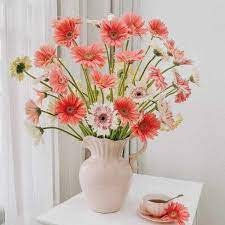**Marigold Flowers in Art and Folk Culture: A Cultural Exploration**

Marigold flowers, with their vibrant colors and rich symbolism, have left an indelible mark on various forms of art and folk culture throughout history. From ancient rituals and religious ceremonies to contemporary celebrations and artistic expressions, marigolds hold a special place in the hearts and minds of people around the world. In this immersive journey, we’ll delve into the multifaceted role of marigold flowers in art and folk culture, exploring their significance, symbolism, and enduring legacy.
**1. Religious and Spiritual Significance:**
Marigold flowers have deep-rooted associations with spirituality, religion, and divine worship in many cultures and traditions. In Hinduism, marigolds are considered sacred to the goddess Lakshmi and are often used to adorn temples, shrines, and religious idols during festivals and ceremonies. The vibrant colors and aromatic fragrance of marigolds symbolize purity, auspiciousness, and devotion, making them an integral part of religious rituals and offerings.
Similarly, in Catholicism and Christianity, marigolds hold symbolic significance in various religious observances and cultural practices. In Mexico, marigolds are prominently featured in Dia de los Muertos (Day of the Dead) celebrations, where they are used to decorate altars, gravesites, and home altars to honor deceased loved ones and guide their spirits back to the earthly realm. The bright orange and yellow hues of marigolds are believed to attract the souls of the departed and provide a path for their return during this annual commemoration.
**2. Festivals and Celebrations:**
Marigold flowers play a central role in numerous festivals, celebrations, and cultural events around the world, where they are used to create colorful displays, intricate decorations, and elaborate garlands. In India, marigolds are a quintessential feature of festivals such as Diwali, Dussehra, and Holi, where they are strung together to make vibrant garlands, rangolis, and floral arrangements. The sight of marigold-adorned streets, homes, and public spaces during these festivities evokes a sense of joy, abundance, and communal unity.
In addition to religious festivals, marigolds are also associated with secular celebrations and seasonal observances in many cultures. In Europe and North America, marigolds are often used to decorate homes, gardens, and public spaces during harvest festivals, weddings, and other special occasions, symbolizing prosperity, happiness, and good fortune.
**3. Folklore and Superstitions:**
Marigold flowers are steeped in folklore, myths, and superstitions that reflect their perceived magical and protective qualities. In traditional European folklore, marigolds were believed to possess the power to ward off evil spirits, protect against witchcraft, and bring good luck to those who cultivated them. Marigold petals were often scattered around doorways, windows, and thresholds to create a barrier against malevolent forces and ensure the safety and well-being of the inhabitants.
Similarly, in Mexican folklore, marigolds are associated with various superstitions and beliefs related to love, fertility, and prosperity. It is said that placing marigold flowers under one’s pillow can induce prophetic dreams, while wearing marigold garlands or amulets can attract love and romance into one’s life. Marigolds are also believed to bring wealth and abundance to those who cultivate them, making them a popular choice for home gardens and agricultural fields.
**4. Artistic Inspiration:**
Marigold flowers have served as a perennial source of inspiration for artists, poets, and writers throughout history, who have immortalized their beauty and symbolism in paintings, literature, and music. From the exquisite still-life paintings of Dutch masters to the lyrical verses of poets such as Pablo Neruda and Emily Dickinson, marigolds have been celebrated for their vibrant colors, delicate petals, and evocative fragrance.
In addition to visual arts and literature, marigolds have inspired musical compositions, dance performances, and theatrical productions that capture the essence of their cultural significance and spiritual resonance. Whether depicted in classical ballets, folk songs, or contemporary art installations, marigold flowers continue to captivate audiences with their timeless allure and universal appeal.
**Conclusion:**
In conclusion, marigold flowers occupy a unique and cherished place in the realms of art and folk culture, where they serve as symbols of beauty, spirituality, and cultural identity. From their religious significance in Hinduism and Catholicism to their role in festivals, folklore, and artistic expressions, marigolds embody the rich tapestry of human experience and imagination. As we continue to celebrate and honor the legacy of marigold flowers, let us remember their profound impact on our lives, cultures, and collective consciousness, inspiring us to appreciate the beauty and wonder of the natural world.


